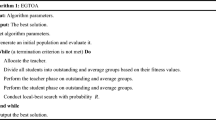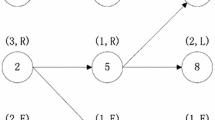Abstract
Due to the NP-hardness of the two-sided assembly line balancing (TALB) problem, multiple constraints existing in real applications are less studied, especially when one task is involved with several constraints. In this paper, an effective hybrid algorithm is proposed to address the TALB problem with multiple constraints (TALB-MC). Considering the discrete attribute of TALB-MC and the continuous attribute of the standard teaching-learning-based optimization (TLBO) algorithm, the random-keys method is hired in task permutation representation, for the purpose of bridging the gap between them. Subsequently, a special mechanism for handling multiple constraints is developed. In the mechanism, the directions constraint of each task is ensured by the direction check and adjustment. The zoning constraints and the synchronism constraints are satisfied by teasing out the hidden correlations among constraints. The positional constraint is allowed to be violated to some extent in decoding and punished in cost function. Finally, with the TLBO seeking for the global optimum, the variable neighborhood search (VNS) is further hybridized to extend the local search space. The experimental results show that the proposed hybrid algorithm outperforms the late acceptance hill-climbing algorithm (LAHC) for TALB-MC in most cases, especially for large-size problems with multiple constraints, and demonstrates well balance between the exploration and the exploitation. This research proposes an effective and efficient algorithm for solving TALB-MC problem by hybridizing the TLBO and VNS.
Similar content being viewed by others
References
BARTHOLDI J J. Balancing two-sided assembly lines: a case study[J]. International Journal of Production Research, 1993, 31: 2447–2461.
LEE T O, KIM Y, KIM Y K. Two-sided assembly line balancing to maximize work relatedness and slackness[J]. Comput. Ind. En., 2001, 40(3): 273–292.
KIM Y K, KIM Y, KIM Y J. Two-sided assembly line balancing: a genetic algorithm approach[J]. Prod Plan Control, 2000, 11(1): 44–53.
BAYKASOGLU A, DERELI T. Two-sided assembly line balancing using an ant-colony-based heuristic[J]. Int. J. Adv. Manuf. Technol., 2008, 36: 582–588.
SIMARIA A S, VILARINHO P M. 2-ANTBAL: An ant colony optimisation algorithm for balancing two-sided assembly lines[J]. Computers & Industrial Engineering, 2009, 56(2): 489–506.
RAO R V, SAVSANI V J, VAKHARIA D P. Teaching-learningbased optimization: a novel method for constrained mechanical design optimization problems[J]. Computer-Aided Design, 2011, 43(3): 303–315.
PAWAR P J, RAO R V. Parameter optimization of machining processes using teaching–learning-based optimization algorithm[J]. Int. J. Adv. Manuf. Technol., 2013, 67: 995–1006.
RAO R V, SAVSANI V J, VAKHARIA D P. Teaching-learningbased optimization: an optimization method for continuous non-linear large scale problems[J]. Information Sciences, 2012, 183(1): 1–15.
MLADENOVIC N, HANSEN P. Variable neighborhood search[J]. Computers & Operations Research, 1997, 24: 1097–1100.
HU X, ERFEI W, YE J. A station-oriented enumerative algorithm for two-sided assembly line balancing[J]. European Journal of Operational Research, 2008, 186: 435–440.
WU E F, JIN Y, BAO J S, HU X F. A branch-and-bound algorithm for two-sided assembly line balancing[J]. International Journal of Advanced Manufacturing Technology, 2008, 39: 1009–1015.
KIM Y K, SONG W S, KIM J H. A mathematical model and a genetic algorithm for two-sided assembly line balancing[J]. Computers & Operations Research, 2009, 36(3): 853–865.
ÖZCAN U, TOKLU B. A tabu search algorithm for two-sided assembly line balancing[J]. International Journal of Advanced Manufacturing Technology, 2009, 43: 822–829.
ÖZCAN U, TOKLU B. Multiple-criteria decision-making in two-sided assembly line balancing: A goal programming and a fuzzy goal programming models[J]. Computers & Operations Research, 2009, 36(6): 1955–1965.
ÖCAN U, TOKLU B. Balancing of mixed-model two-sided assembly lines[J]. Computers & Industrial Engineering, 2009, 57(1): 217–227.
HU X F, WU E F, BAO J S, et al. A branch-and-bound algorithm to minimize the line length of a two-sided assembly line[J]. European Journal of Operational Research, 2010, 206(3): 703–707.
ÖZCAN U. Balancing stochastic two-sided assembly lines: A chance-constrained, piecewise-linear, mixed integer program and a simulated annealing algorithm[J]. European Journal of Operational Research, 2010, 205(1): 81–97.
ÖZBAKIR L, TAPKAN P. Balancing fuzzy multi-objective two-sided assembly lines via bees algorithm[J]. Journal of Intelligent & Fuzzy Systems, 2010, 21(5): 317–329.
ÖZBAKIR L, TAPKAN P. Bee colony intelligence in zone constrained two-sided assembly line balancing problem[J]. Expert Systems with Applications, 2011, 38(9): 11947–11957.
TAPKAN P, OZBAKIR L, BAYKASOGLU A. Bees algorithm for constrained fuzzy multi-objective two-sided assembly line balancing problem[J]. Optimization Letters, 2012, 6(6): 1039–1049.
CHUTIMA P, CHIMKLAI P. Multi-objective two-sided mixed-model assembly line balancing using particle swarm optimisation with negative knowledge[J]. Computers & Industrial Engineering, 2012,62(1): 39–55.
BIAO Y, CHAOYONG Z, XINYU S. A late acceptance hill-climbing algorithm for balancing two-sided assembly lines with multiple constraints[J]. J. Intell. Manuf., 2015, 26(1): 159–168.
BEAN J. Genetics and random keys for sequencing and optimization[J]. ORSA Journal on Computing, 1994, 6(2): 154–160.
HANSEN P, MLADENOVIC N. Variable neighborhood search: Principles and applications[J]. European Journal of Operational Research, 2001, 130: 449–467.
Author information
Authors and Affiliations
Corresponding author
Additional information
Supported by National Natural Science Foundation of China (Grant Nos. 51275366, 50875190, 51305311) and Specialized Research Fund for the Doctoral Program of Higher Education of China (Grant No. 20134219110002)
TANG Qiuhua, born in 1970, is currently a professor at Wuhan University of Science and Technology, China. She received her PhD degree from Wuhan University of Science and Technology, China, in 2005. Her research interests include production planning and scheduling and industrial engineering.
LI Zixiang, born in 1990, is currently a postgraduate at Wuhan University of Science and Technology, China. He received his bachelor degree from Wuhan University of Science and Technology, China, in 2013.
ZHANG Liping, is currently a lecturer at Wuhan University of Science and Technology, China. She received her PhD degree from Huazhong University of Science and Technology, China, in 2013. Her research interest include dynamic scheduling, job shop scheduling and intelligent algorithm.
FLOUDAS C A, is currently a professor at Texas A&M University, USA. His research interests include product and process systems engineering, and bioinformatics and computational genomics.
CAO Xiaojun, born in 1974, is currently a senior engineer at Technique Center of Dongfeng Peugeot Citroen Automobile Company, China. He received his bachelor degree from Huazhong University of Science and Technology, China, in 1996.
Rights and permissions
About this article
Cite this article
Tang, Q., Li, Z., Zhang, L. et al. Effective hybrid teaching-learning-based optimization algorithm for balancing two-sided assembly lines with multiple constraints. Chin. J. Mech. Eng. 28, 1067–1079 (2015). https://doi.org/10.3901/CJME.2015.0630.084
Received:
Revised:
Accepted:
Published:
Issue Date:
DOI: https://doi.org/10.3901/CJME.2015.0630.084




